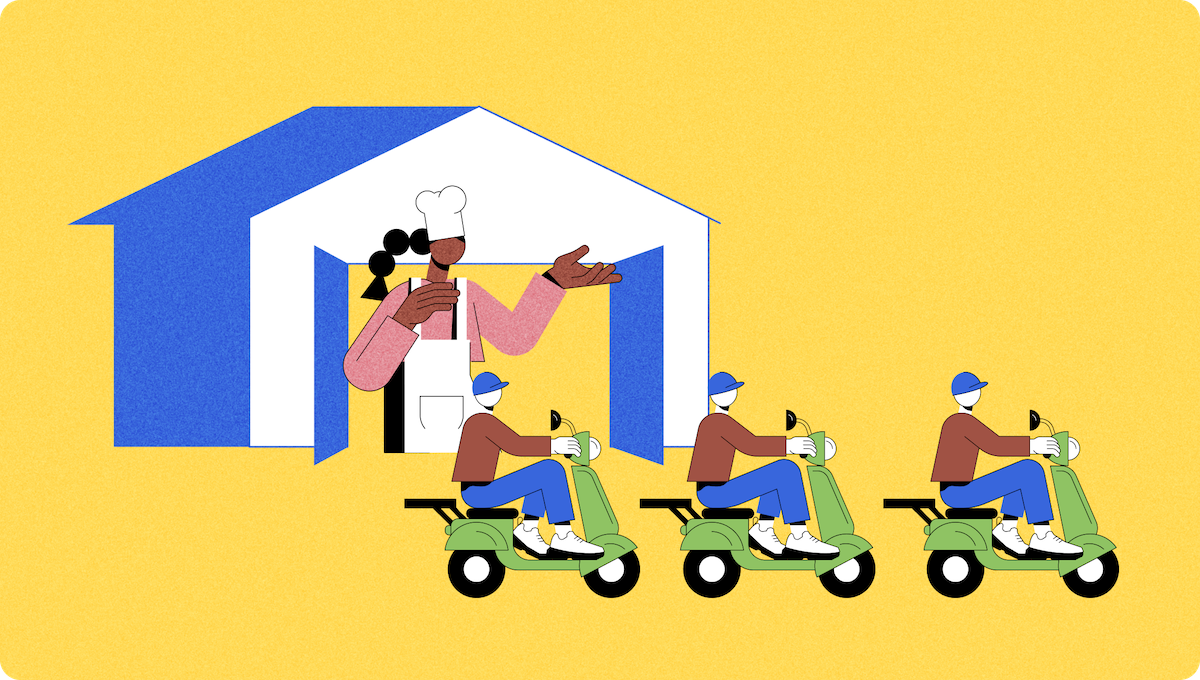Selling without a storefront: how ghost retail is shaping the on-demand market

It all started with food. As the restaurant business struggled to adapt to the growing challenge of social isolation and mandatory lockdowns in the wake of COVID-19, they began taking orders online to survive the demand shortage.
The on-demand food economy has flourished in the last couple of years, from $16.8 billion in 2018 to $28.5 billion in 2020 in the US alone. But traditional dine-in restaurants were often ill-suited to meet the growing demand for consistent and timely delivery, leading to the development of virtual food service brands with no storefronts.
Ghost kitchens, or on-demand restaurants with no traditional dine-in arrangements, were able to reduce costs on infrastructure and deliver cheaper and better quality food optimized for the online delivery market.
The grocery and retail industry soon followed suit, introducing dark stores that didn’t have any physical storefronts to speak of. Instead, each brick-and-mortar “store” was merely a coworking space facilitating on-demand deliveries through online orders.
In this survival guide for retail operations teams, we look at how ghost kitchens and dark stores have forever changed the on-demand market to provide a faster and more seamless experience.
It’s never enough to have a website
Thanks to deceptive marketing campaigns and poor business advice, many business leaders still think that all they need to launch an online store is to start a website and begin accepting online orders. However, the reality is far more complicated.
Brick-and-mortar stores and dine-in restaurants are often ill-suited for the online marketplace because their existing systems—from store layout to inventory management—are built with physical retail in mind.

Communicate seamlessly with buyers.
The biggest challenge for brick-and-mortar retailers is translating the in-store customer experience for an online audience. What worked in physical retail may not necessarily work with online customers. In contrast, repeat customers may feel let down if your online experience isn’t consistent with the physical one.
Of course, that isn’t the only challenge. Brick-and-mortar stores also have to contend with two of the greatest issues of our time: Real estate and labor. Commercial real estate prices are rising yearly, with the great resignation leading to one of history’s most severe labor shortages in the wake of COVID-19.
Unlike virtual stores, physical retailers and dine-in restaurants don’t have the luxury of working around these challenges to provide a better customer experience online. Successful businesses optimize for on-demand from start to finish. That’s why it’s not enough just to have a website.
What makes ghost retail different?

Ghost retailers are explicitly built for the on-demand economy. They understand the online marketplace better than anyone and can use search engine optimization and social media marketing to propel their businesses. They can also cut costs on physical infrastructure to focus their capital investments on on-demand.
Drawing on the example of ghost kitchens, virtual restaurants can cut costs on property rent, food and drink licenses, and labor costs to offer cheaper and better food deliveries. They can also use online-only tools like chat to further increase social engagement and improve the customer experience.
Apart from virtual kitchens, ghost retail can also take the form of dark stores—brick-and-mortar establishments with no physical storefront, designed singularly for the purpose of on-demand storage and delivery. Dark stores aren’t open to the public, but they facilitate on-demand orders taken via online platforms. For example, Whole Foods has been investing heavily in dark stores across the US, starting with Brooklyn in 2020.
Not all ghost retailers begin their journey as online-only platforms. They can also be offshoots of existing physical retailers with a renewed focus on on-demand services. However, the key to on-demand success is a strong knowledge of the online customer base coupled with a business model focusing on social growth.
Why communication is so important
The success of an on-demand delivery platform is tied to how well it understands its community. Online customers behave differently from those who walk into your store because they have a completely different spectrum of needs and pain points. To succeed in an online marketplace, you need to understand a specific customer segment and develop a unique solution for their struggles and challenges.
You may want to integrate a communications system into your on-demand delivery platform for several reasons. It can be an asset for your sales and marketing teams while enabling you to provide better customer support. It can also help you issue real-time notifications about deliveries and keep everyone on the same page to avoid confusion. A good communications platform also has gamification features like ratings and comments to increase social engagement.
iFood chose Sendbird to implement in-app chat to improve communication between delivery drivers and customers. iFood can integrate custom data to share locations, maps, and delivery status directly in chat.
But the biggest asset of having an in-app communications system is the amount of data you can collect to find out more about your customer base. You can learn about their unique preferences, challenges, and struggles—and then use that information to create a more tailored offering.
Sendbird is an off-the-shelf real-time communications solution that helps on-demand delivery platforms strengthen their offering. Our live chat, voice calling, and video conferencing features enable you to stay in touch with customers and employees simultaneously via a single interface. Social engagement tools like service ratings and push notifications to let you further enrich the on-demand experience.
Want to learn more about Sendbird? Talk to our sales team to get started today!










